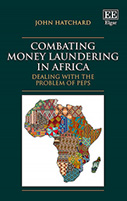Combating Money Laundering In Africa: Dealing With The Problem Of Peps

Author: John Hatchard
Publisher: Cheltenham, UK; Northampton MA: Edward Elgar, 2020, 277p.
Reviewer: Neil Boister | May 2021
John Hatchard is the leading expert on the suppression of corruption in Africa. His latest book, Combating Money Laundering in Africa: Dealing with the Problem of PEPs, focuses on money laundering by politically exposed persons (PEPs) in Africa. Corruption on the scale that he writes about at the hands of these political leaders causes significant damage to African economies with extensive social cost. For Hatchard, the goal of policy and lawmakers must be effective action in stemming laundering of the proceeds of corruption by PEPs. He proposes a three-pronged approach to achieve this goal, consisting of effective anti-money laundering laws and institutions, effective anti-money laundering investigations prosecutions and asset recovery, and addressing the bribe payers to discourage them from entering into corrupting activities.
In part one, the book examines the nature of the problem. It shows how PEPs backed by syndicates use institutions to engage in corruption. PEPs are both uniquely influential because of their influential positions (including in the running of the anti-money laundering system itself) as well as uniquely vulnerable because of their prominence, as they are subject to constitutional controls and external oversight particularly by the media. The global financial system serves to assist PEPs – through money laundering by professionals, tacit cooperation of financial institutions and facilitating state havens. Hatchard asks provocatively whether it is African states that are corrupt, or whether it is the western states, which provide a place to hide the proceeds of that corruption, which are corrupt. Later in the book, he raises for example the role of British overseas territories in money laundering. Seeking balance, he also points out China’s non-participation in regional systems to control corruption in Africa despite its extensive interests in the continent.
To lay the groundwork for a discussion of actual practice, the book surveys the legal framework at the international and national level, laying out the current rules and institutions operating to suppress money laundering and corruption. As well as a description of the Financial Action Task Force and regional analogues of the FATF, the author discusses unique African efforts such as the Panel on Illicit flows from Africa. When examining the international and national legal frameworks and institutional structures and activities, Hatchard makes the point that trying to create a system of uniform laws in all African states to make it possible to cooperate against corruption is impossible; what the system seeks to do is achieve functional equivalence among national legal systems in Africa. Nevertheless, looming in the background is the question of the practical effectiveness of these laws and institutions.
Part two moves into the practice, highlighting the roles of domestic and international regulatory agencies. What the book reveals, in a number of case studies, is that the quite detailed powers of African states on paper are not complemented by their capacity to control illicit flows from corruption. The book is peppered with examples of attempts to control money laundering. Hatchard’s long familiarity with Africa makes this depth of research possible. The discussion of the use of constitutions as an anti-money laundering instrument in chapter 6 is particularly interesting. The author illustrates how the constitution can become a battleground between PEPs and law enforcement. Also particularly thought provoking is chapter 7’s discussion of the importance of the Auditor General (referred to as the ‘ally of the people’) as part of the anti-money laundering scheme — because of their ability to penetrate deeply into the financial system to reveal corruption. However, as Hatchard explains, PEP’s do try to limit these powers. For example, the discussion of the Kenyan decision in Transparency International (TI Kenya) v Attorney General [2018] eKlr shows how the constitution was used to block any attempts to limit the Auditor General’s powers. The book wades through the difficulties of prosecuting PEPs, such as the legal immunity attaching to high-ranking politicians while still in office, and law-reform is the watchword. The discussion of asset recovery is mainly about non-conviction-based forfeiture, particularly where the assets are held extraterritorially. The author advocates the use of every possible tool including civil litigation to retrieve these assets.
In the final part of the book, Hatchard turns to the bribe payers themselves and how they can be disincentivized from paying bribes through prosecutions, disbarment and other methods familiar in modern practice. The penultimate chapter is dedicated to unusual steps like the as yet only proposed criminal chamber of the African Court of Justice to take jurisdiction over money laundering offences, and the serious problems with doing so when the only predicate offence is corruption.
Hatchard concludes by arguing that there are reasons to hope for the future, and that the system has come a long way relatively quickly. The examples he gives of successful litigation may still be outweighed by the massive amounts of money flowing out of Africa, but the book adds to the rising consciousness of how steps can be taken to stem the flow. A gold mine of practice from Africa, this book makes strong use of illustrative examples, and functions as a comprehensive guide as to what can and should be done to stop money laundering by African PEPs.


